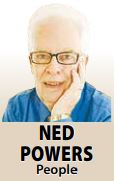
Steve Smith once envisioned his alter-ego, Red Green, as a 1978 summer replacement television show with the potential of lasting a year.“
I was going to have some fun with someone who saw himself as a do-it-yourselfer in the outdoors. But Red Green had a longer lifeline than I ever imagined,” said Smith on the telephone from Hamilton. The Red Green Show lasted for 300 episodes from 1991 to 2006, finishing in high style on the CBC in Canada and PBS in the United States. It still has a massive re-run market. Smith then decided to take his hero on tour, with the fourth and current one aptly named This Could Be It.
The performance is coming to the Broadway Theatre in Saskatoon for two shows at 3 and 7 p.m. on Oct. 6. Saskatoon is one of eight Canadian cities that has commanded a double-header booking.“ When my wife Morag and I were on TV with the Smith & Smith Show, I introduced Red Green as a caricature in a parody about a television fishing show. That’s where Red got his original voice, which came from a whispering tone, and the plaid shirt, the suspenders. When Morag decided not to do our own show anymore, I looked at Red as my answer to keep working.“ It wasn’t easy at first. It took four years to get a permanent TV placement. But the show worked. We turned Red Green from a caricature into a character, and when the fans loved him, we had to be true and honest in our approach. Some will say that Red Green is the man who sees life a little differently than anyone else.”

Broadway Theatre on Oct. 6. (Online Photo)
Smith said he pitched CBC every summer on the show’s potential. “I’m not sure they liked the idea, but they sure liked the audience numbers we were attracting with our own self-produced show. We wound up with a nine-year run on CBC.” Part of the success was due to the down-home approach of the show’s characters, the creation of the Possum Lodge set, the frequency of outdoor shoots and Smith’s own devotion to the writing.“
I think there’s a little bit of a handyman in all of us. If I hadn’t been a little bit handy, this never would have worked. Some of us become much better handymen than others. Our show’s highlight was the penchant to solve everything with duct tape. With Possum Lodge, I wanted to create a special world, a special location. It became rather noteworthy and tourists would often believe it was a real destination place. “Many fans have been watching every episode since the beginning. There was never a time when we could think about repeating a segment. We had to be fresh; I always kept a file of about 100 storylines as a safety factor.” The other secret was the imaginative characters.“
I was at a Canadian awards show one year and Graham Greene, an actor of considerable skill, came up to me and asked what did he have to do to get a role on the show. I told him he was in. Another time I was judging an Oktoberfest parade in Kitchener alongside Jeff Lumby, who was a morning radio personality. He came loaded with multiple impersonations. He became the perfect fit as the sewage and septic tank technician.” Lumby was born in Saskatoon, the son of John and Helen Lumby, who were both employed by CFQC-TV. Patrick McKenna and Bob Bainborough were among those who came through the ranks of Second City. “Once you enjoy the laughs while being on stage, you carry it into every adventure,” said Smith. “The bottom line is that in 15 years of production, no one ever uttered a harsh word on our sets.”
Today on the road, Smith sticks to what worked for the TV audiences.“ We have enjoyed success in the United Sates; most didn’t know it had a Canadian origination. They likely thought it was originated in Wisconsin or Michigan. We are never political. And maybe that’s a refreshing change from what is happening in United States today.” The Red Green Show is simply Smith on stage. But he will get phone calls from McKenna (who played Green’s nephew, Harold) Lumby (who played Winston Rothschild III) and Peter Keleghan (who played Ranger Gord).
-Ned Powers
